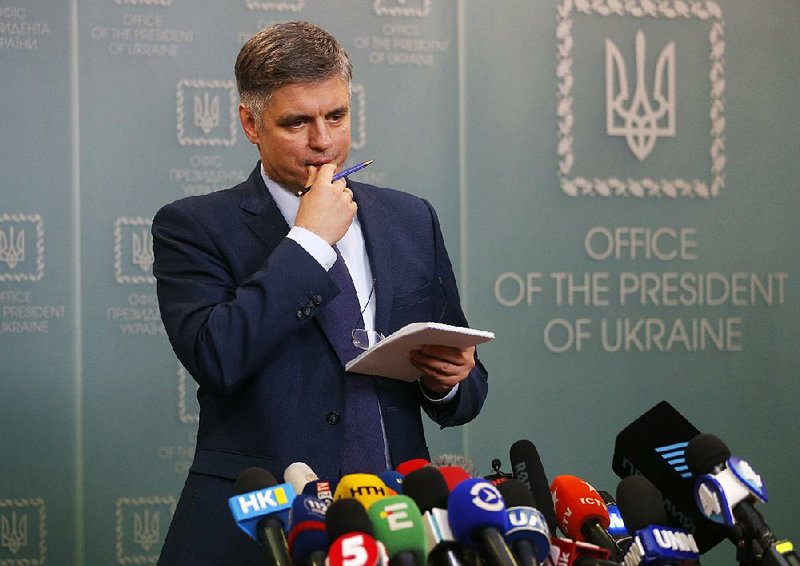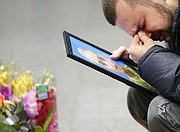TEHRAN, Iran -- Iran announced today that its military "unintentionally" shot down a Ukrainian jetliner, killing all 176 aboard.
The statement blamed "human error" for the shoot-down.
The jetliner, a Boeing 737 operated by Ukrainian International Airlines, went down on the outskirts of Tehran during takeoff just hours after Iran launched a barrage of missiles at U.S. forces.
Iran had denied for several days that a missile downed the aircraft. But then the U.S. and Canada, citing intelligence reports, said they believed Iran shot down the aircraft.
A military statement carried by state media outlets said the plane was mistaken for a "hostile target" after it turned toward a "sensitive military center" of the Revolutionary Guard. The military was at its "highest level of readiness," it said, during the heightened tensions with the United States.
"In such a condition, because of human error and in a unintentional way, the flight was hit," the statement said. It apologized for the disaster and said it would upgrade its systems to prevent such "mistakes" in the future.
It also said those responsible for the strike on the plane would be prosecuted.
Ukraine's main intelligence agency had said Friday that it had narrowed the possible causes of the airplane crash in Iran to either a missile strike or a terrorist act.
[Video not showing up above? Click here to watch » https://www.youtube.com/watch?v=mm9GdylGII0]
Ukraine said it had received "important data" from U.S. officials on Friday after President Volodymyr Zelenskiy pleaded for Western leaders to provide the intelligence that they said suggested Ukraine International Airlines Flight 752 was downed by an Iranian missile, possibly fired by mistake.
It was not immediately clear what details were passed to Zelenskiy. But U.S. officials and those from other countries, including Canada and Britain, have said intelligence reports strongly suggested that an Iranian surface-to-air missile sent the plane plunging in a fireball, leaving no survivors.
Iran had denied the assertions that the Boeing 737-800, carrying 176 people from Tehran to Kyiv, was shot down early Wednesday shortly after departing from Iran's capital.
Ali Abedzadeh, head of Iran's Civil Aviation Organization, had said at a televised news conference that he was "certain that no missiles hit the aircraft."
Iran's semiofficial Fars News Agency reported that findings on the cause of the crash would be announced today after a meeting of Iranian and foreign investigators.
The Iranian stance had remained sharply at odds with Western views on the likely fate of the aircraft even as Tehran said it would welcome international experts to take part in the investigation.
The air disaster unfolded just hours after Iran fired more than a dozen short-range ballistic missiles at military bases hosting American troops in Iraq -- retaliation for a U.S. drone strike that killed a top Iranian military commander, Gen. Qassem Soleimani, in Baghdad last week.
Soleimani's killing sent regional tensions soaring, and Iranian officials vowed to avenge his death. They portrayed the missile attacks on U.S. troops in Iraq, which caused no casualties, as a show of strength. The Ukrainian plane had carried more than 80 Iranian passengers.
At the crash site, Iranian crews in red-and-white uniforms gathered the wreckage and remnants from passengers' luggage and personal items that escaped the flames. Oleksiy Danilov, secretary of Ukraine's National Security and Defense Council, said Ukrainian crash investigators were also at the site. Iranian officials said the pieces of the plane and other debris were moved to a hangar for examination.
"Normally you would very carefully map out a debris field. If a missile struck the airplane, you would expect to find some pieces of it and residue of the explosive," said Steven Wallace, former head of the accident-investigations office of the U.S.' Federal Aviation Administration.
Jeff Guzzetti, a former accident investigator and FAA official, said he would not be troubled by a cleanup if the Iranians first documented the exact location of every large piece, stored them properly and agreed to let investigators from the U.S. and other countries inspect them.
Tracing the debris and figuring out what parts fell off first can help investigators establish the cause of a crash. Broken pieces are examined closely for things like metal fatigue.
Parts can be swabbed for chemical residue and examined for holes or peppering that could indicate an explosion. That is how Dutch-led investigators determined that a Malaysian Airlines plane that crashed in Ukraine in 2014 had been shot down in an attack blamed on pro-Russia rebels.
Prystaiko said at a news conference Friday that Ukraine has been granted access to the flight-recorder data, but wants the "black boxes" back in Kyiv. He added that investigators are analyzing plane parts, including chemical residue on the wreckage, and the remains of passengers.
Ukraine has taken an active role in investigating the crash of the jet, which was carrying 11 Ukrainians, including the crew. A team of 45 experts and search-and-rescue personnel from Ukraine, including specialists who helped investigate the July 2014 downing of Malaysia Airlines Flight 17 over Ukrainian territory, arrived in Tehran early Thursday to participate in the investigation.
Ukraine's president had phone conversations Thursday with heads of government from Canada, Britain, Sweden and Iran -- countries that each had citizens among the passengers. Zelenskiy encouraged the countries to participate in the investigation, but asked that any evidence be shared with Kyiv.
"Given the recent statements by the heads of state in the media, we call on all international partners, especially the governments of the United States, Canada and the United Kingdom, to provide data and evidence relating to the disaster to the commission investigating the causes," Zelenskiy said in a statement on Facebook.
"Our goal is to ascertain the undeniable truth," Zelenskiy said in his statement Friday. "We believe this is the responsibility of the whole international community before the families of the dead and the memory of the victims of the catastrophe."
The Ukrainian leader spoke with Secretary of State Mike Pompeo on Friday and wrote on Twitter that he was grateful for the "valuable support of the U.S. in investigating the causes of the plane crash. Information obtained from the U.S. will assist in the investigation." Speaking Friday at the White House, Pompeo said the United States believes it's "likely" an Iranian missile downed the plane.
Zelenskiy spokeswoman Iuliia Mendel wrote on Twitter earlier Friday that Zelenskiy and Prystaiko met with U.S. officials and "received important data that will be studied" by Ukraine's specialists. Prystaiko said Ukraine also received British intelligence information and it was similar to what the Americans had provided.
"I don't like to answer questions beginning with 'what happens if,' but, definitely, if it's proven -- if we prove -- that this plane was shot down, certainly, we will demand not only that all those responsible be held accountable, but also compensation," Prystaiko said.
In Washington on Friday, U.S. officials had expressed "high confidence" that the Boeing 737-800 was targeted by an SA-15 surface-to-air missile, part of a Russian-made air defense system also known as a Tor system, as Iranian forces were on high alert. President Donald Trump said the downing of the aircraft was probably a "mistake."
Then in Ottawa, Canadian Prime Minister Justin Trudeau said intelligence analyses indicated that a surface-to-air missile hit the plane in what could have been an "unintentional" act. In London, British Prime Minister Boris Johnson cited a "body of information that the flight was shot down by an Iranian surface-to-air missile."
A Ukrainian official, speaking on the condition of anonymity because the person was not authorized to comment publicly, said Zelenskiy made the public request for evidence about the crash because the United States had not yet provided Ukraine with its information about the missile Thursday.
"The theory that the plane was hit by a missile is not ruled out, but it is not confirmed so far," Zelenskiy said. Danilov, the Ukrainian defense secretary, wrote on Facebook that his team was considering several possible causes but wanted to search for any evidence of a Tor air-defense missile strike, after seeing online reports about the discovery of probable fragments of one near the crash site.
The Washington Post obtained a video purporting to show the moment the plane was struck in midair. The video, first published by The New York Times, purportedly shows a missile intercepting the aircraft near the city of Parand, followed by a loud boom.
Abedzadeh, Iran's aviation chief, said Friday that video "cannot be confirmed." If the United States and other Western countries "have any technical information [about the crash], they can provide us with it. American officials must substantiate their claims with technical evidence," he said.
Abedzadeh previously said that the pilot gave no distress call before the crash. He said the aircraft was on fire for over a minute and turned around "to come back to the airport."
"There could be different reasons why the pilot didn't contact the control tower," Abedzadeh said. "It could have been because his first priority was to save the plane."
Several minutes after takeoff, Abedzadeh said, the pilot contacted the Mehrabad airport, which also services Tehran, and asked for permission to climb to 26,000 feet. Shortly after that the plane caught fire, he said.
Earlier Friday, the Iranian government said in a statement that it was inviting Boeing to send a representative to help examine the black box containing the flight data and cockpit voice recorders. Iranian state television aired a video of an investigator opening and showing the contents of the box.
Information for this article was contributed by Isabelle Khurshudyan, Erin Cunningham, David Stern, Shane Harris and Brian Murphy of The Washington Post; by David Koenig of The Associated Press; and by staff of The New York Times.
A Section on 01/11/2020

